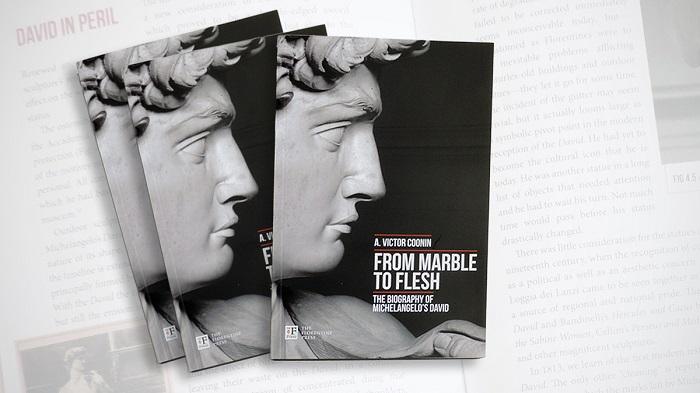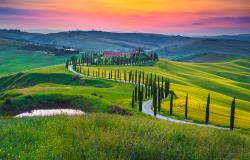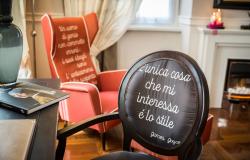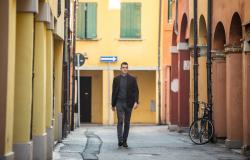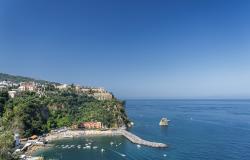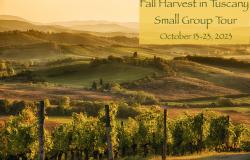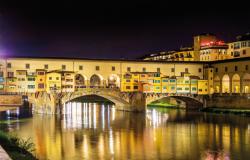What makes Michelangelo’s David so famous?
Victor Coonin, an art history professor at Rhodes College in Memphis, TN, has recently published a book that sets out to answer this apparently basic question. From Marble to Flesh. The Biography of Michelangelo’s David is an attractively illustrated trade paperback that will appeal to Italy lovers and art lovers around the world – even, and perhaps especially, those without any art history training. We sat down with the author (virtually) and with Alexandra Korey, his editor at The Florentine Press, an independent Florence-based publishing house, who shared this daring journey with him.
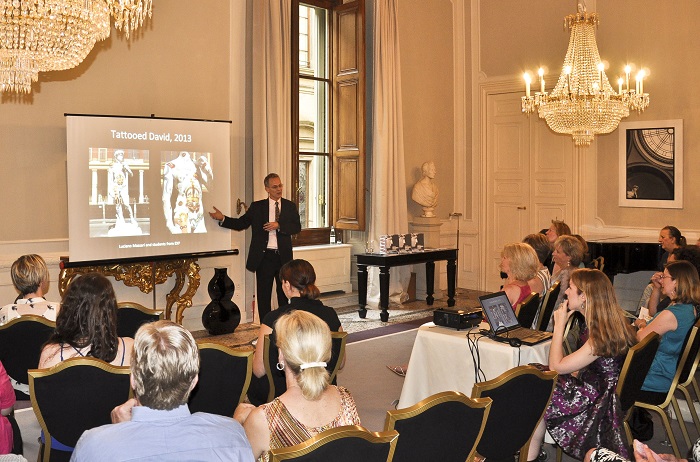
What made you want to write an entire book on this famous statue?
VC: Well, I’ve been a professor for 20 years now, and along with teaching surveys on Italian Renaissance Art, I usually lead a seminar course on Michelangelo. I’ve taught this course at all levels, including to adults. The discussion always gets very lively when we get to the David. Students come in with a certain amount of knowledge about this work of art because it’s so very famous, and frequently reproduced – as is, for example, his counterpart in painting, Leonardo’s Mona Lisa. My students inspired my book because they would frequently ask me why he is so famous. The question required years of research to resolve.
How is this book relevant to us now?
VC: There’s a very contemporary aspect to this book, especially in the final chapter, where I consider how and why numerous contemporary artists and pop culture creators have responded to the David. I think he may be the only Renaissance statue to figure in both The Simpsons and Spongebob Squarepants! Groundbreaking artists like Andy Warhol and Banksy have reinterpreted the figure. David’s been given breasts, and blown up into a twice-his-size Ken doll. So we’re not just talking about the figure’s past life, but his impact in the present day.
AMK: Being contemporary and being relevant now is a really important issue when you’re considering publishing any book! Indeed, we’re looking at a 500-year old statue of a religious figure, which could seem not at all relevant to the modern public. But then you consider the number of people who line up outside the Accademia each year just to see him (1.26 million) and you do have to admit that there’s something about this statue that draws our attention! There’s also a timeliness to the publication: in 2014, we’re celebrating the 450th anniversary of the death of Michelangelo. But aside from that, The Florentine Press wanted to be sure that people were interested in the book, so we ran a campaign on the crowdfunding platform Kickstarter, and the positive reaction we got provided very useful affirmation of our choice.
Right, Italy Magazine published an article while the Kickstarter campaign was running – how did that go?
AMK: It went great – thanks, in part, to you guys for spreading the word so well! We had a $5,000 (USD) goal and we actually met that within the first 12 days, and we raised a total of $7,296 from 157 backers. Not only did we pre-sell about a hundred books this way, but we garnered a lot of interest, and of course it was a way to confirm our choice to publish this book, because people showed that they really are interested in the David and his story as told in an approachable manner.
VC: It was interesting to see the process of crowdfunding – it’s something I’d heard of but not yet participated in; Alexandra proposed it to me as the only viable way to raise funds to print the book in as many copies as we wanted, and I was willing to give it a shot. I am the first of my colleagues to have gone through this experience! It’s probably the only Italian art history book to be funded on Kickstarter.
So, getting back to the book itself, what challenges did you run into writing, and then publishing, this book?
VC: The biggest challenge in writing the book is that there have been volumes upon volumes already penned about Michelangelo and about the David, and I had to sort through it all. One generally assumes that some of the past’s greatest scholars wrote things that were correct and definitive, and what I discovered is that a lot of supposed “facts” were repeated from one text to the next. But when I actually checked the documents or simply looked at the statue itself, I realized they were wrong. For example, David holds a sling that he uses to kill Goliath, and we just assume that he’s holding a rock in his right hand, so this is often repeated, even in scholarly books. One just has to look at the statue from behind to see that it’s actually the handle of the sling, not a rock. Essentially, beyond solid research, my methodology simply involves a lot of close looking. As for publishing, Alexandra can fill you in on the challenges there. From the point of view of the author, though, the tough part was finding a publisher with a similar vision to mine. I had interest from academic presses, but I didn’t want the book to be very costly and to reach a limited public. I also didn’t want a coffee-table book that people would look at, but not read. The book is an unusual hybrid, being both scholarly and written in an accessible way for the general reader. There are very few art history books written in this way.
AMK: Indeed, when Victor contacted me, he said he wanted to make a book that lots of people would want to read! The text already fit the bill, but it is hard to pin down the genre of the book. It’s not historical fiction, and it’s not watered down art history, either. The Florentine Press publishes books “inspired by Florence” so this gives us a fair amount of flexibility as to genre; and we do have mostly art-related books in our roster. We also share a vision of “making art accessible”. It’s something we’ve been doing with books by Jane Fortune, an independent researcher in Florence’s museum archives who found works by those she calls “Invisible Women”, female artists over the centuries whose works are little known, and she raises money to restore them. That book is also for the general public, and the PBS documentary based on it won an Emmy award! Back to your question, the challenge for us was to get sufficient funding to cover the active costs of printing a book of this type – full colour offset printing on good quality paper, printed in Italy, is a costly endeavor. But the results are spectacular and this is a book that will last forever.
Tell us one fun fact that no-one knows about the David.
VC: Did you know that parts of the David have been broken off and reattached? The incident regarding his left arm is the best known break – in 1527 there were uprisings in the city, and someone actually threw a bench at the rioters outside the Palazzo Vecchio. The bench went through the window… and fell on Michelangelo’s statue! It broke the arm into several pieces, which Vasari claims he personally collected from the ground (when he was a young man) and returned to the city’s Medici leader. Anything that sticks out from a sculpture is actually subject to breaking, so the toes have had a few breaks, and a finger on the right hand has also been broken off.
So do you talk about David’s famous nude parts?
VC: Absolutely. That’s one of the biggest questions people have about the statue: “why is he naked?” Historically, the story of the David involves an adolescent shepherd who, helped by divine inspiration, takes on the giant Goliath with only a slingshot. Technically we should be looking at a lanky boy dressed in a basic tunic. Other artists before Michelangelo had already taken poetic license with the figure of the David – mainly the Florentine sculptor Donatello. Michelangelo is the first to make David entirely nude in the manner of ancient sculpture, as if he is clothed in nothing other than faith. It is a beautiful metaphor. As for one specific “famous nude part” as you put it, a lot of people ask why his penis is so small, and also uncircumcised. There’s actually a whole chapter subsection about this in the book and I don’t want to “reveal it all”, but again there are important metaphors about the male in control of his body and the perfection of the human form reflecting an uncorrupted internal character. There’s no question the choice is also an engineering one – not only is a less protruding member less likely to get chopped off with time, it is easier for the sculptor to not make a crucial mistake while he’s carving!
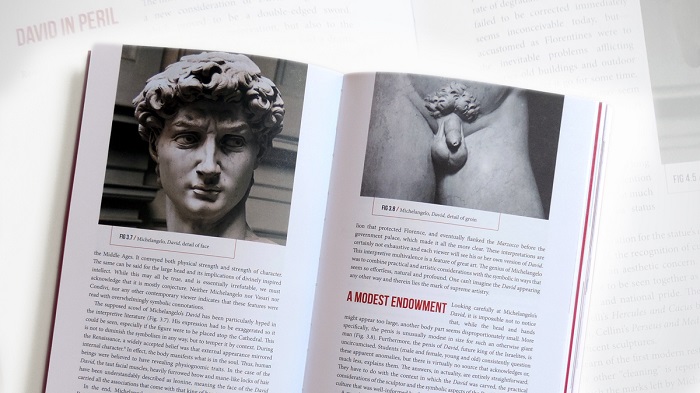
What makes this book stand out from all of the other books focusing on David?
AMK: From Marble to Flesh is unlike all the Michelangelo books I know. Namely, it’s Victor’s easygoing narrative voice that makes the biggest difference. The idea that you can talk about something “deep” with a general, interested public is not one that all authors embrace. There seems to be a division between purely scholarly texts, which may be great but really, nobody but an art historian wants to read those, and purely “tourist” books that focus on beautiful photography but often little text. There are no other books that focus specifically on the David that combine such a reputable and readable text with outstanding images.
VC: Indeed, I tell the whole story of this statue, which doesn’t start with Michelangelo and a block of marble, but with a concept developed by the patrons of the Cathedral before Michelangelo was even born. We trace the arduous journey of the block of marble from Carrara to Florence, we see other artists work on the block before Michelangelo, and we look at how Michelangelo ended up being the artist to complete the work. After its installation, we consider how people reacted to it over the centuries. That’s why I call the book a biography, because it’s a statue that has a life-like existence that continues to this very day.
Is this book also available in Italian? If so, how do you see this book having commercial success in Italy?
AMK: For the moment, the book is only available in English, though we’d be interested in entertaining offers to have it translated into other languages. The Florentine Press is an English publishing house in Florence – we also produce the monthly newspaper The Florentine – so that’s our area of specialty. We primarily had an Anglo-Saxon public in mind when producing the book as we know that the biggest Italy-loving audience is from the USA and the UK – really, the readers of this website! But we are seeing much interest from Italian readers, and in general we can say that the book is already having commercial success in Italy since the book is available in bookstores and museum gift shops in Florence and it is selling well.
Got more questions for Alexandra and Victor? More pressing doubts about the David? Ask them here and we’ll make sure you get an answer.
Want to read From Marble to Flesh. The Biography of Michelangelo’s David right away? Buy the paperback on the ITALY Magazine Shop. Special offer for ITALY Mag readers! Buy the book for 25€ + free 6 issues PDF subscription to The Florentine + free shipping in Italy, USA and UK. Offer expires December 10, 2014.

